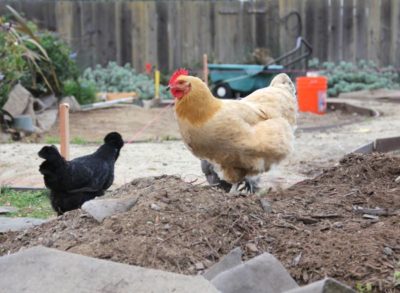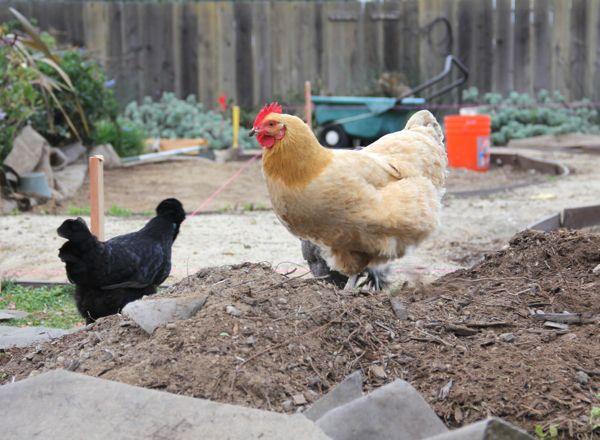
Image source: chickenblog.com
Gardening is often the first thing people will try when moving toward a more sustainable lifestyle. Chickens can also be a welcome addition to your lifestyle, adding protein to your diet, manure to your garden, and entertainment. You might find yourself pondering the question as to whether your garden and your chickens can somehow mix, and not to the detriment of either one of them.
We have tried a variety of ways of keeping chickens. I personally like to let our birds run free, truly free-ranging and coming back to the coop at night, but I realize that not everyone has this option. There is wisdom to being open to trying something new as things around the homestead and our lifestyles change from year to year.
Before we think about ranging chickens in our gardens, there are some things to consider about letting your chickens free-range on your property.
Consider your space
How much space do you have to work with? You will want to gauge the number of chickens you let run on your place by the square footage of the property they will be allowed access to. Most people overestimate the number of chickens their space can handle, and this leads to problems such as over-foraging that leaves areas of barrenness and chicken poo all over the place. Not the effect you are looking for, I suspect.
An inspiring guide to self-reliance, sustainability, and green living for city dwellers.
Generally speaking, it is recommended to have 8- to 10-feet of space per standard-sized chicken (4 square feet for bantams) for outdoor pen space. For free-ranging, you will want to generously overestimate the outdoor space needed. If you are living in town, you will have much less space for your chickens to range than if you were in a suburban or rural area. Keep that in mind, and adhere to the number of chickens per space recommendations for best results.
Consider your neighbors
You will need to consider your neighbors as you consider free-ranging your chickens. It’s one thing for the neighbor to look out and see a lone chicken on the corner of their property. It’s quite another if your whole flock of 25 chickens has decided that the neighbor’s front porch, complete with swing and rocking chairs, is an awesomely comfortable place to hang out all day. You might have a neighbor that doesn’t mind that kind of “company,” but that would be pretty rare.
If you are considering free-ranging your chickens, and your neighbors live nearby, you will need to discuss how you will protect your neighbor’s property(including their garden) and keep the peace between you. This may mean adding fencing around your property to keep your chickens within your space. You will also want to consider if the neighbors allow their dogs to run the neighborhood, as dogs have the potential to destroy a flock in a very short amount of time.
Full-time ranging vs. part-time ranging
Once you’ve figured out the number of chickens your property can easily handle, and how to make it work with your neighbors, you will need to consider the details of free-ranging. Will you be home all day, every day? Or do you have days where you run to town for part of the day or you work away from home? These are things you need to consider. We personally prefer that our chickens get full time free-ranging, but we paid the price of this one year when we left for 2 hours and came home to find most of our flock killed by “free-ranging,” trespassing dogs. This was after years of successful free-ranging with no incidences, and we’d gotten careless.
We now have our chickens out only on days/times when someone is home. This means that if we’d planned on staying home all day and someone invites us to go on a quick run to town, we have to either decline the invitation or go try to round up the birds and get them into the safety of the chicken coop. Inconvenient? Yes, but if we want to have fresh eggs from free-range chickens, it’s a commitment we’ve needed to make.
Protecting your flock
When allowing your chickens to free-range, you need to think about how they will be protected. Think about the potential predators in your area and potential need to fence your property (possibly with electric). Think about the proximity to the road. Think about harsh weather conditions. Think about any toxins they might get into. Free-range can be a good thing, but not if you lose your flock due to them not being protected.
Protecting your garden
Here we get to the nitty-gritty. The things you really want to know, right? The main question I had been wanting to know is how to keep the chickens from destroying my beloved garden when they are free-ranging.
This handbook provides an introduction to key aspects of raising and breeding chickens.
There are three occasions that I find my garden most needs protection from the chickens: 1) at planting time when I have seeds and seedlings I want undisturbed, 2) when chickens are eyeing my lovely greens, and, 3) when I have ripening produce (especially tomatoes).
Aside from the obvious option of completely surrounding your garden with fencing to keep the chickens out, here are suggestions on how to help your chicken and garden coexist:
1. Chicken tractors. Chicken tractors aren’t just for “mowing” your grass. A chicken tractor that you move every day down rows of your garden will allow the chickens to eat bugs, scratch around and aerate your soil, fertilize and generally be happy chickens, while also protecting your plants from chicken attacks. This gives the chickens the benefits of free-ranging, yet they are more or less protected from predators. Instructions for how to build a chicken tractor are all over the Internet. Find one that will work for you and go for it!
2. Temporary plant cages. If you’d like to give your chickens more free-range opportunity, you can place temporary wire cages (chicken wire can work well for this) over areas you have recently planted, and over tender seedlings, tempting greens and ripening produce. This will allow the chickens to more or less free-range the rest of the garden and prevent them from ruining your crop. You might consider placing these cages over newly mulched areas as well, if you don’t want your curious chickens rearranging it for you.
3. Supervised ranging. This would mean that you would let the chickens out in the evening and let them have free-range of the garden while you work somewhere nearby, keeping a watchful eye on them to keep them out of mischief. Evening is best, since they will tend to go back home to the coop as the sun sets.
4. Divide the garden into multiple runs/areas. This method works best if your chicken coop is located very close to the garden and the chickens can walk from their coop directly into the garden. You can divide the garden into runs with chicken wire and fence posts and herd your chickens to the proper area for the day or have multiple doorways/gates from the chicken coop area to the areas of the garden.
Happy gardening and happy chicken raising!
